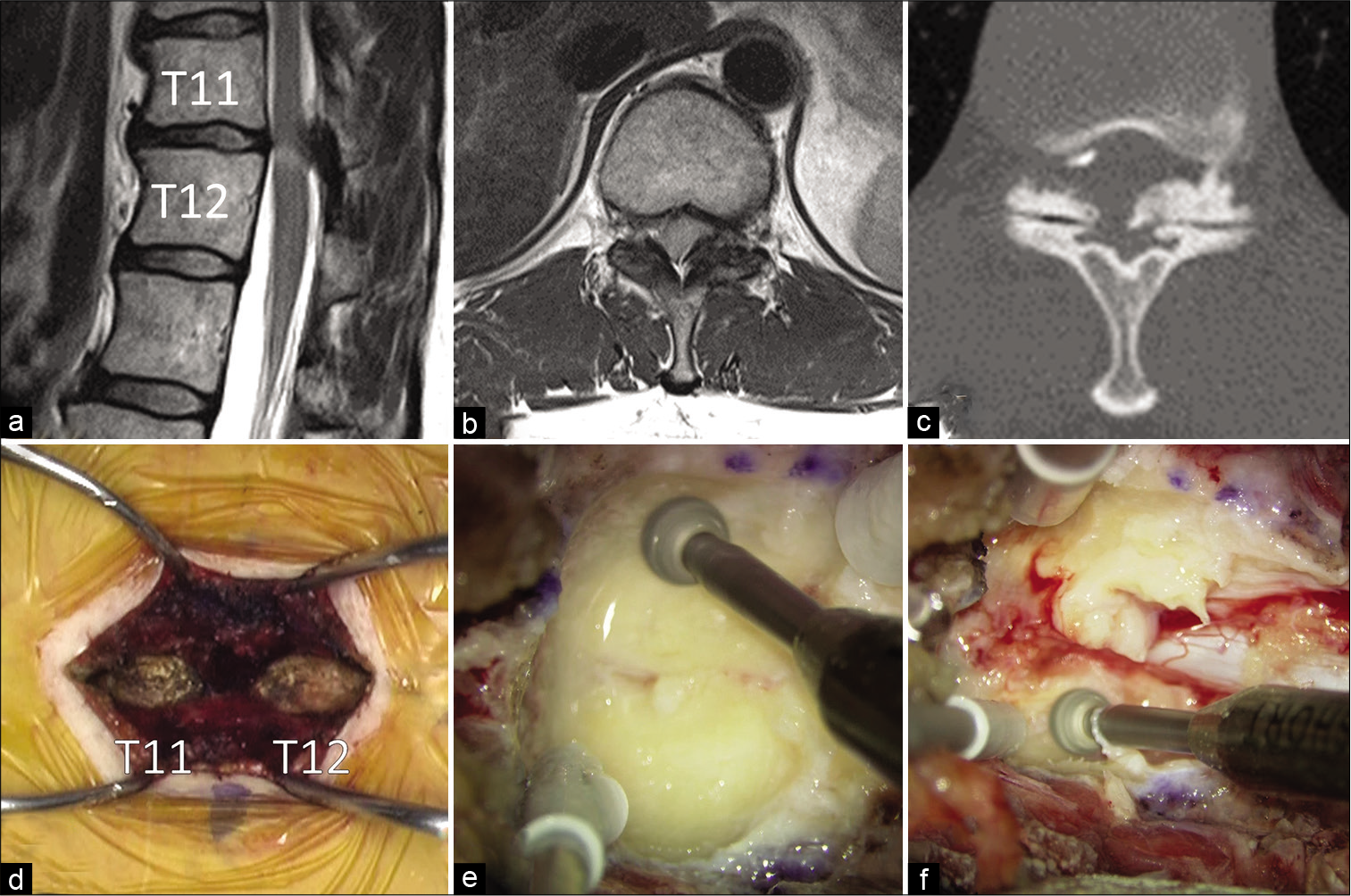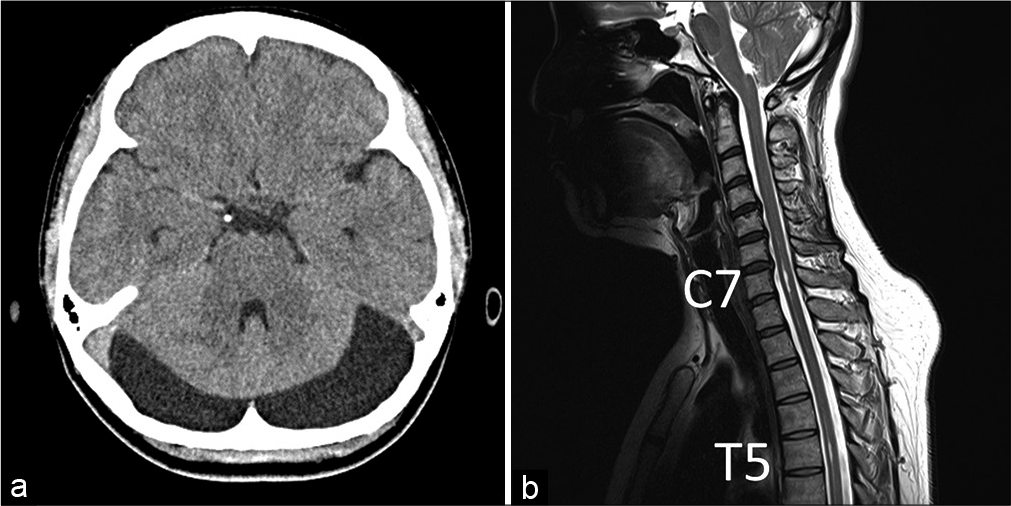- Department of Neurosurgery, Fuji Brain Institute and Hospital, Fujinomiya-shi, Shizuoka, Japan.
DOI:10.25259/SNI_404_2021
Copyright: © 2021 Surgical Neurology International This is an open-access article distributed under the terms of the Creative Commons Attribution-Non Commercial-Share Alike 4.0 License, which allows others to remix, tweak, and build upon the work non-commercially, as long as the author is credited and the new creations are licensed under the identical terms.How to cite this article: Toshiya Aono, Hideaki Ono, Takeo Tanishima, Akira Tamura, Isamu Saito. T11/T12 ossification of the yellow ligament contributing to thoracic myelopathy in patient with posterior fossa arachnoid cyst and acquired incidental Chiari I malformation/syrinx. 31-May-2021;12:246
How to cite this URL: Toshiya Aono, Hideaki Ono, Takeo Tanishima, Akira Tamura, Isamu Saito. T11/T12 ossification of the yellow ligament contributing to thoracic myelopathy in patient with posterior fossa arachnoid cyst and acquired incidental Chiari I malformation/syrinx. 31-May-2021;12:246. Available from: https://surgicalneurologyint.com/surgicalint-articles/10837/
Abstract
Background: Thoracic ossification of the yellow ligament (OYL) may contribute to myelopathy. In the case presented, the patient additionally had a chronic posterior fossa arachnoid cyst with an acquired Chiari I malformation and cervicothoracic syrinx.
Case Description: A 40-year-old female with a posterior fossa arachnoid cyst found 17 years ago, and newly acquired Chiari I malformation (tonsils down 5 mm) with a C7-T5 syrnix, presented with the new onset of lower extremity myelopathy. The MR documented marked dorsolateral cord compression due to T11/T12 OYL. Six months following a laminectomy for resection of OYL, the patient was asymptomatic.
Conclusion: In patients presenting with the new onset of lower extremity myelopathy, evaluation of the complete neuraxis may be warranted. Here, the patient has an unchanged posterior fossa arachnoid cyst with an acquired Chiari I malformation/C7-T5 syrinx. However, the patient’s symptoms were fully attributed to the MR-documented T11/T12 OYL that was successfully resected.
Keywords: Acquired Chiari malformations, Arachnoid cyst, Myelopathy, Ossification of the yellow ligament, Syringomyelia
INTRODUCTION
Thoracic myelopathy caused by thoracic spinal stenosis and ossification of the yellow ligament (OYL) is relatively rare and may be overlooked.[
Here, we present a 40-year-old patient with a 17-year history of a chronic posterior fossa arachnoid cyst and acquired Chiari I malformation/C7-T5 syrinx, whose acute thoracic myelopathy was attributed to the MR-documented T11/T12 OYL. Following a decompressive laminectomy, the patient experienced full symptom resolution.
CASE DESCRIPTION
History
A 40-year-old female presented with thoracic myelopathy of 4 months’ duration (i.e. mild bilateral lower extremity weakness, left leg hyperreflexia, and decreased light touch/ pain perception at/below T11).
When the MR showed T11/T12 OYL resulting in cord compression (i.e. the lesion was hypointense on T2-weighted images while the CT showed it was ossified), the patient successfully underwent a bilateral laminectomy of T11/T12 with progressive resolution of the myelopathy over 6 postoperative months [
Figure 1:
Pre- and intraoperative findings of T11/T12 ossification of the yellow ligament (OYL). (a-c) The lesion was hypointense on T2-weighted images (a and b) while the CT showed it was ossified (c). (d) The vertebral arches of T11/T12 were exposed. (e) Bilateral laminectomy of T11/T12 was performed, and a thick OYL was found. (f) The OYL was drilled thin and resected piece by piece, and the dura mater was confirmed.
DISCUSSION
In this case, the patient’s new acute symptoms of thoracic myelopathy were attributed to the T11/T12 OYL. As the patient’s predominant symptoms consisted of lower extremity myelopathy attributed to the MR-documented T11/T12 OYL, the patient successfully underwent a decompressive T11/T12 laminectomy. Notably, the CT and MR findings of a posterior fossa arachnoid cyst (unchanged over 17 years), an acquired Chiari malformation[
CONCLUSION
In patients presenting with the new onset of lower extremity myelopathy, evaluation of the complete neuraxis may be warranted. We successfully diagnosed and treated T11/T12 OYL contributing to thoracic myelopathy in patient with posterior fossa arachnoid cyst and acquired Chiari malformation/syrinx.
Declaration of patient consent
The authors certify that they have obtained all appropriate patient consent.
Financial support and sponsorship
Nil.
Conflicts of interest
There are no conflicts of interest.
References
1. Ahn DK, Lee S, Moon SH, Boo KH, Chang BK, Lee JI. Ossification of the ligamentum flavum. Asian Spine J. 2014. 8: 89-96
2. Aizawa T, Sato T, Sasaki H, Kusakabe T, Morozumi N, Kokubun S. Thoracic myelopathy caused by ossification of the ligamentum flavum: Clinical features and surgical results in the Japanese population. J Neurosurg Spine. 2006. 5: 514-9
3. Ando K, Imagama S, Kobayashi K, Ito K, Tsushima M, Morozumi M. Clinical features of thoracic myelopathy: A single-center study. J Am Acad Orthop Surg Glob Res Rev. 2019. 3: e.10.5435
4. Galarza M, López-Guerrero AL, Martínez-Lage JF. Posterior fossa arachnoid cysts and cerebellar tonsillar descent: Short review. Neurosurg Rev. 2010. 33: 305-14
5. Wang J, Alotaibi NM, Samuel N, Ibrahim GM, Fallah A, Cusimano MD. Acquired chiari malformation and syringomyelia secondary to space-occupying lesions: A systematic review. World Neurosurg. 2017. 98: 800-8.e2







